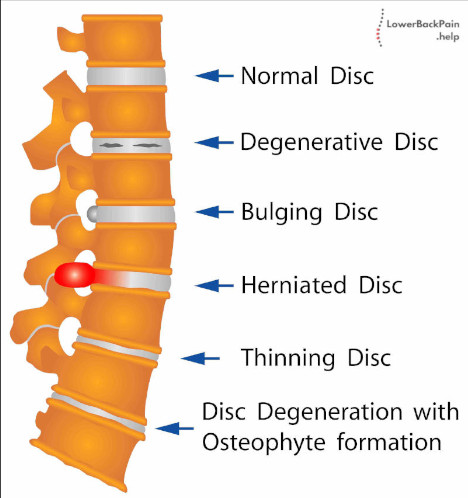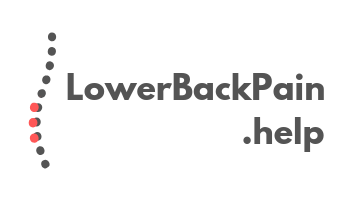Table of Contents
Millions of people worldwide suffer from back pain.
In fact, every second American who has a regular job suffers from some sort of back pain every year.
And the lumbar region, or the lower back, is where the majority of back pain occurs.
We’re about to explain what puts you at risk for lumbar pain, as well as some of the most common causes for this kind of pain. Let’s dig in!
What’s Inside Your Lower Back?
So, what is lumbar pain exactly? To answer that, we’ll first need to understand the anatomy of your lower back.
The lower back, called the lumbar region, contains five different vertebrae, labeled L1-L5 as you can see in the picture below. These vertebrae support most of your upper body weight.
In between these vertebrae are a set of soft, round discs that prevent the bones from rubbing together, and also act as shock absorbers.
There’s also an array of ligaments that tie the vertebrae together, and tendons that connect muscles to the vertebrae for added support.
31 pairs of nerves extend through gaps in the vertebrae, connecting your nervous system to your entire lower body.
These nerves control your muscles, as well as sending signals back and forth between your brain and your body.
If one of those nerves gets pinched, it can lead to excruciating pain.
But that is not the only possible reason for pain in the lower back area: damage to the bones, muscles, ligaments, or discs can also cause pain.
Risk Factors For Lumbar Pain
Now that you know some basics of how the lower back works, we should take a closer look at what might put you at risk for lumbar pain.
The first risk factor is age.
As we get older, our bones lose density, our muscles lose flexibility, and our intervertebral discs start to lose their springiness.
All of these factors can cause the “aches and pains” that come with the later part of life.
But genetic factors can also play a role. Read an article about the impact of your genes on your lower back pain here.
Certain conditions, such as ankylosing spondylitis, can cause stiffness, pain, and discomfort.
Obesity is another major risk factor.
The more weight your spine has to carry, the more stress it will be under.
And the more stress it’s under, the more pain you’re likely to experience.
For the same reason, pregnancy can also cause lumbar pain. Read more about it here.
Fortunately, symptoms almost always disappear after the baby has been delivered.
Overall physical fitness is a risk factor in back pain.
The more you exercise and the better shape you’re in, the stronger the muscles supporting your spine will be.
Conversely, if you spend most of your time sitting down, your back muscles aren’t going to maintain a lot of strength. This is especially true if you’re inactive during the week and spend your weekends engaging in intense physical activity.
The best way to strengthen your back muscles is through low-impact aerobic exercise.
Closely related is your job.
If your job requires you to do a lot of lifting, twisting, pushing, or pulling, it puts stress on your back.
On the different end of it, a desk job can also cause back pain, due to lack of exercise.
Bad posture in your desk chair can further exacerbate existing back issues, so a supportive chair is a must. We have put together an article on how you can get through your day with lower back pain if you have a desk job here.
Back pain in children is very often caused by an overloaded backpack.
Carrying around a heavy backpack full of school books and other supplies can cause pain for students. Keeping unused books in a locker and using a well-fitted backpack can help alleviate this. Think about this the next time you check the backpack of your child.
Causes of Lumbar Pain
Most lower back pain results from mechanical causes.
In acute cases, the primary causes are sprains and strains.
These are often confused with each other, so let’s clarify:
Sprains are caused by overstretched or torn ligaments, while Strains are caused by stretched or torn tendons or muscles.
That said, they come from similar causes.
In the case of back pain, they’re most likely caused by heavy lifting or twisting.
Mechanical back pain is also something that is more common with seniors.
As said above when we were looking at the risk factors, due to loss of bone density and muscle strength, as well as everyday wear and tear, the lumbar region can develop pain as you age.
Another cause can also be caused by the breakdown of intervertebral discs. These discs are filled with fluid, which makes them soft and rubbery.
As we age, that fluid can slowly leak out, which makes the discs less effective at absorbing shock.
A more extreme example of mechanical back pain is a herniated disc.
A herniated disc has become deformed and can press against the nerves that run along the spine. Here is more about herniated discs.

A herniated disc can lead to extreme pain.
When the vertebrae are pressing directly on the nerves it is called radiculopathy and results in tingling, severe pain, or even numbness.
Because these spinal nerves extend throughout the whole lower body, radiculopathy can result in pain down an entire leg, or throughout the back, stomach, or buttocks.
Perhaps the most well-known form of radiculopathy is called sciatica. In sciatica, the vertebrae are pressing on the sciatic nerve, which runs over your buttocks and down the back of your leg.
As a result, sciatica can be a truly debilitating condition. Learn more about sciatica here.
Lumbar pain can also result from more mundane causes, such as a traumatic injury.
A car accident, a fall, or a sports injury can result in strains, and even spinal compression, which can cause a variety of issues, including a herniated disc.
Finally, skeletal conditions can cause lumbar pain. The most common form of skeletal abnormality is scoliosis, or a curved spine, which affects 1 to 2% of the population.
When to Visit a Doctor
Under most circumstances, lower back pain is not a cause for serious medical concern.
That said, there are a handful of conditions that warrant a visit to your doctor. Here are a few of them:
- Infections don’t generally cause back pain. However, an infection in the intervertebral discs can cause pressure on adjacent nerves. Vertebral infections can also cause this kind of pain. These infections can be cleared up with a course of antibiotics. It is not very common but still a possible complication.
- Tumors generally don’t affect the lower back. However, an unusual bulge is a cause for medical concern and should be checked by a health professional.
- Cauda equine is caused when fluid from a damaged disc gets injected into the spinal canal. When this happens, the fluid can compress all of the nerves from the lumbar region. The good news is that the symptoms are obvious – loss of bladder and bowel control. The bad news is that the damage can become permanent if left untreated.
